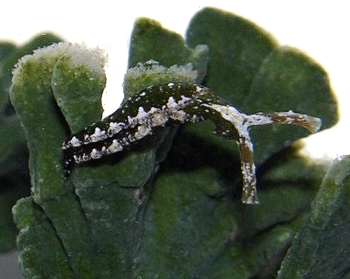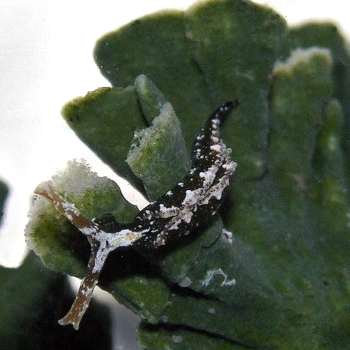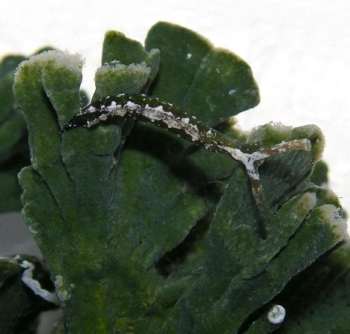

Elysia sp. 13
Order: SACOGLOSSA
Superfamily: ELYSIOIDEA
Family: Elysiidae
DISTRIBUTION
Caribbean
PHOTO
Hurricane Hole 2, Stocking Island, Exumas, Bahamas, February 7, 2005. Depth appx 6 feet of water. Size was approximately 7 mm. It was found on algae - probably Udotea flabellum. Photo: Anne DuPont
"The rhinophores look a little like E. papillosa, but the color and markings look like E. tuca. It was found in the same bay that I found typical specimens of E. tuca and E. papillosa."
Anne DuPont
Rudman, W.B., 2005 (September 12) Elysia sp. 13 [In] Sea Slug Forum. Australian Museum, Sydney. Available from http://www.seaslugforum.net/find/elyssp13
Related messages
Re: Elysia from the Bahamas
September 13, 2005
From: Kathe R. Jensen
Dear Anne & Bill,
Concerning message #14645:
After looking at Anne's pictures of E. tuca [#14654]and E. papillosa [#14653], I now venture to say that the animal is the present message is definitely not E. tuca. The rhinophores are much to long, and the parapodia are held in a different manner. In E. tuca the parapodia always look as if they are glued together, except for the "chimney" in the middle. I am not sure whether it is E. papillosa or maybe an undescribed species. I had some arguments with Kerry Clark about the radular tooth shape of E. papillosa. He had collected animals in Bermuda, which I think were on Halimeda, and their teeth were much different from the ones I had collected from Penicillus in the Florida Keys. So there may be more than one very similar species.
Best wishes,
Kathe
krjensen@snm.ku.dk
Jensen, K.R., 2005 (Sep 13) Re: Elysia from the Bahamas. [Message in] Sea Slug Forum. Australian Museum, Sydney. Available from http://www.seaslugforum.net/find/14754Thanks Kathe,
I'll call it Elysia sp. 13.
Best wishes,
Bill Rudman
Elysia from the Bahamas
August 27, 2005
From: Anne DuPont


Hello Bill,
I found this Elysia in the southern Bahamas. Can you identify it please? The rhinophores look a little like E. papillosa, but the color and markings look like E. tuca. It was found in the same bay that I found typical specimens of E. tuca and E. papillosa.
Location: Hurricane Hole 2, Stocking Island, Exumas, Bahamas, February 7, 2005. Depth appx 6 feet of water. Size was approximately 7 mm. It was found on algae that I think was Udotea flabellum.
Thank you,
Anne DuPont
Delray Beach, FL
akdupont@bellsouth.net

Dear Anne,
On the hope that the food might help I had a look at the food of the two species you mentioned. Kerry Clark (1984) reports E. papillosa feeding on algae of the genera Halimeda, Penicillus and Udotea and E. tuca is reported to mainly feed on Halimeda, which suggests that neither can be canceled out on food specificity. I think we will have to see if Kathie Jensen has an opinion. To my untutored eye they are not papillate enough for E. papillosa and in that species and E. tuca the upper half of the rhinophores are white while in your animal they are not.
Best wishes,
Bill Rudman
